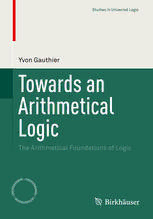Table Of ContentStudies in Universal Logic
Yvon Gauthier
Towards an
Arithmetical
Logic
The Arithmetical Foundations of Logic
Studies inUniversalLogic
SeriesEditor
Jean-YvesBéziau(FederalUniversityofRiodeJaneiroandBrazilianResearchCouncil,
RiodeJaneiro,Brazil)
EditorialBoardMembers
HajnalAndréka(HungarianAcademyofSciences,Budapest,Hungary)
MarkBurgin(UniversityofCalifornia,LosAngeles,USA)
RazvanDiaconescu(RomanianAcademy,Bucharest,Romania)
JosepMariaFont(UniversityofBarcelona,Spain)
AndreasHerzig(CentreNationaldelaRechercheScientifique,Toulouse,France)
ArnoldKoslow(CityUniversityofNewYork,USA)
Jui-LinLee(NationalFormosaUniversity,HuweiTownship,Taiwan)
LarissaMaksimova(RussianAcademyofSciences,Novosibirsk,Russia)
GrzegorzMalinowski(UniversityofŁódz´,Poland)
DarkoSarenac(ColoradoStateUniversity,FortCollins,USA)
PeterSchröder-Heister(UniversityTübingen,Germany)
VladimirVasyukov(RussianAcademyofSciences,Moscow,Russia)
Thisseriesisdevotedtotheuniversalapproachtologicandthedevelopmentofageneral
theoryoflogics.Itcoverstopicssuchasglobalset-upsforfundamentaltheoremsoflogic
and frameworksforthe study of logics, in particularlogicalmatrices, Kripke structures,
combinationoflogics,categoricallogic,abstractprooftheory,consequenceoperators,and
algebraiclogic.Itincludesalsobookswithhistoricalandphilosophicaldiscussionsabout
the nature and scope of logic. Three types of books will appear in the series: graduate
textbooks,researchmonographs,andvolumeswithcontributedpapers.
Moreinformationaboutthisseriesathttp://www.springer.com/series/7391
Yvon Gauthier
Towards an Arithmetical Logic
The Arithmetical Foundations of Logic
YvonGauthier
UniversityofMontreal
Montreal
Québec,Canada
ISSN2297-0282 ISSN2297-0290 (electronic)
StudiesinUniversalLogic
ISBN978-3-319-22086-4 ISBN978-3-319-22087-1 (eBook)
DOI10.1007/978-3-319-22087-1
LibraryofCongressControlNumber:2015949819
MathematicsSubjectClassification(2010):01-02,03-02,03-A05,13F-20,14-02
SpringerChamHeidelbergNewYorkDordrechtLondon
©SpringerInternationalPublishingSwitzerland2015
This work is subject to copyright. All rights are reserved by the Publisher, whether the whole or part of
the material is concerned, specifically the rights of translation, reprinting, reuse of illustrations, recitation,
broadcasting,reproductiononmicrofilmsorinanyotherphysicalway,andtransmissionorinformationstorage
andretrieval,electronicadaptation,computersoftware,orbysimilarordissimilarmethodologynowknownor
hereafterdeveloped.
Theuseofgeneraldescriptivenames,registerednames,trademarks,servicemarks,etc.inthispublicationdoes
notimply,evenintheabsenceofaspecificstatement,thatsuchnamesareexemptfromtherelevantprotective
lawsandregulationsandthereforefreeforgeneraluse.
Thepublisher,theauthorsandtheeditorsaresafetoassumethattheadviceandinformationinthisbookare
believedtobetrueandaccurateatthedateofpublication. Neitherthepublishernortheauthorsortheeditors
giveawarranty,expressorimplied,withrespecttothematerialcontainedhereinorforanyerrorsoromissions
thatmayhavebeenmade.
Printedonacid-freepaper
SpringerInternationalPublishingAGSwitzerlandispartofSpringerScience+BusinessMedia
(www.birkhauser-science.com)
Dedicatedto thememoryof thegreat
arithmeticianAndréWeil
Foreword
Theprojectofanarithmeticallogichasbeeninthemakingformanyyearsandthepresent
work is the continuation of my 2002 book Internal Logic. Foundations of Mathematics
from Kroneckerto Hilbert (Kluwer,Dordrecht).In the interveningyears,I have pursued
the programme and I have published many scientific papers and a book in French on
the subject. The progress made towards an arithmetical logic is here recorded, but the
idea of an internal logic of arithmetic has not been altered. It is still the inner structure
of classical arithmetic or number theory, which is the objective of the foundational
enterprise.IhavebaptizedthatarithmetictheFermat-Kronecker(FK)arithmeticandIhave
constantlyopposedit to Peano arithmetic.What I have beentrying to show is thatthere
isnoset-theoreticelementinpurearithmetic,whilePeanoorDedekind-Peanoformalized
arithmeticisembeddedinatransfiniteset-theoreticframework.Kronecker’sfinitiststand
in mathematics extends from Hilbert to contemporary constructive mathematics, e.g.
Bishop’s constructive analysis and Nelson’s predicative arithmetic. Gödel’s ‹extended
finitism›oftheDialecticaInterpretationcouldbecountedasamitigatedreappropriation
of Kronecker’s radical constructivism via Hilbert’s introduction of functionals inherited
fromKronecker’shigher-orderforms(polynomials).ThisisoneofthemainthemesIhave
proposedintherecentyears.
The centralthesis of this book has been expandedto coverthe constructivistinsights
in physics and mathematical physics, from relativity theory to quantum physics and
cosmology where I have attempted to explore the ramifications of the constructivist-
finitist motives. My objective here has been to elaborate on the foundational aspects
of arithmetical logic—the proper name of which I have dubbed modular polynomial
logic—with incursions in probability theory and theoretical and mathematical physics.
Atthe sametime, I havebeentryingtosee whatisconceptually(andtechnically)going
on in contemporary‹real› mathematicsfrom the constructivistviewpointof arithmetical
foundations,withouttoomuchprejudiceastowhatconstitutesmathematicalpracticewith
orwithoutfoundationalconcerns.Still,needlesstosaythatconstructivistfoundationsare
inherently critical of mathematical (and logical) practice in classical logic and classical
mathematics,butthecritiquecomesfromwithin,thatiswithoutinvokingprinciplesthat
arealientomathematicalactivityinitshistorical,epistemologicalandrationalpursuits.
vii
viii Foreword
Inthatendeavour,themainsourceofmyinspirationremainsAndréWeilwithwhomI
discoveredbothFermatandKroneckerinthe1980s.Earlyon,AndréWeilhadencouraged
mein correspondencetoexplorefurtherthemathematicalvirtuesofFermat’smethodof
infinitedescentandIdiscoveredatthesametimetheimportanceofKronecker’sgeneral
arithmeticinWeil’soriginalwritingsonalgebraicgeometry(seehisŒuvresscientifiques.
CollectedWorks,Springer-Verlag,3vols,1980)—seemyreviewGauthier(1994b)ofWeil
(1992).Weil has put Kronecker’stheory of formsor homogeneouspolynomialsand his
divisor theory (moduli systems) at the very beginning of algebraic-arithmetic geometry
with the emphasisonfinite fieldswhereFermat’sinfinitedescentisatwork.I mustalso
acknowledgethebeneficialexchangesIhavehadoveraperiodofyears,eitherinpersonal
contactsorincorrespondencewithHenriMargenau,A.Wheeler,E.P.Wigner,I.M.Segal,
G.Chew,RenéThom,N.A.Shanin,H.M.Edwards,EdNelson,G.Kreisel,Y.Gurevich,
U.Kohlenbach,H.Putnam,D.vanDalen,A.Urquhart,A.Joyal,BasvanFraasseneither
forscientificcounsels,criticalassessmentsorfriendlyapprovals.Allhavecontributedto
myunderstandingofthemanyfacetsoffoundations,maytheybelogical,mathematical,
physicalorphilosophical.
Inthewritingofthisopus,Ihavedrawnfreelyfrompreviouswork,mytwobookson
thesubjectInternalLogicmentionedaboveandLogiquearithmétique.L’arithmétisation
delalogique(PUL,Québec,2010)andnumerouspapersthathaveappearedinrecentyears
in a varietyof scientific journals, Synthese,Logiqueet Analyse, Revue internationalede
philosophie,FoundationsofScience, InternationalStudiesin the Philosophyof Science,
Reports on Mathematical Logic, International Journal of Theoretical Physics, Journal
of Physical Mathematics, International Journal of Pure and Applied Mathematics and
Reports on Mathematical Physics. Some of the ideas that are still on the forefront here
haveappearedinearlierpublicationsinModernLogic,ZeitschriftfürmathematischeLogik
und Grundlagen der Mathematik and Archiv für mathematische Logik und Grundlagen-
forschung,ZeitschriftfürallgemeineWissenschaftstheorie,Notre-DameJournalofFormal
Logic,DialecticaandPhilosophyofScience,butthoseideashavetakenonnewclothesin
myup-to-datesynthesis.Ihavecompletedthewritingofthisworkinthesummerandfall
of 2014, not without the assistance of my two LATEX men, David Montminy and Benoit
Potvin.BenoitPotvinhasmadeitpossibleformetobeuptotherequirementsofscientific
journals by diligently latexizing my papersin the last five years. He is here thanked for
hisexpertiseasacomputerscientist.IalsowishtothanktheCanadianResearchCouncil
(SSHRC)forfundingmyresearchinthelastfouryears(andmanyyearsbefore!).Finally,
IamgratefultoJean-YvesBéziauwhohashadasympatheticearandafriendlyreception
tomyworkovertheyears.
Montreal YvonGauthier
August2015
Contents
1 Introduction:TheInternalLogicofArithmetic................................. 1
2 ArithmetizationofAnalysisandAlgebra ........................................ 5
2.1 CauchyandWeierstrass ...................................................... 5
2.2 DedekindandCantor......................................................... 6
2.3 Frege .......................................................................... 13
2.4 Russell,PeanoandZermelo.................................................. 15
2.5 KroneckerandtheArithmetizationofAlgebra ............................. 19
3 ArithmetizationofLogic........................................................... 25
3.1 HilbertafterKronecker....................................................... 25
3.2 Hilbert’sArithmetizationofLogicandtheEpsilonCalculus .............. 28
3.3 Herbrand’sTheorem.......................................................... 32
3.4 Tarski’sQuantifierElimination .............................................. 33
3.5 Gödel’sFunctionalInterpretation............................................ 34
3.6 SkolemandBrouwer ......................................................... 39
3.7 GödelandTuring............................................................. 40
3.8 Arithmetic..................................................................... 43
3.9 ConstructiveArithmeticandAnalysis....................................... 46
3.10 Complexity.................................................................... 50
4 Kronecker’sFoundationalProgrammeinContemporaryMathematics..... 55
4.1 Introduction................................................................... 55
4.2 Grothendieck’sProgramme.................................................. 59
4.3 Descent........................................................................ 60
4.4 Langlands’Programme....................................................... 63
4.5 Kronecker’sandHilbert’sProgrammesin Contemporary
MathematicalLogic .......................................................... 65
4.6 Conclusion:FinitismandArithmetism...................................... 68
5 ArithmeticalFoundationsforPhysicalTheories ................................ 71
5.1 Introduction:TheNotionofAnalyticalApparatus.......................... 71
5.2 AnalyticalandEmpiricalApparatuses....................................... 72
ix

